Zuo-Guang. Ye Advanced Dielectric Piezoelectric and Ferroelectric Materials: Synthesis, Characterisation and Applications
Подождите немного. Документ загружается.

Handbook of dielectric, piezoelectric and ferroelectric materials450
the ferroelectric phase, and that a paraelectric cubic phase exists below
30 nm.
15.3 The relaxor ferroelectric
Pb(Mg
1/3
Nb
2/3
)O
3
–PbTiO
3
solid solution
PMN is a prototype of relaxor. Its dielectric permittivity as a function of
temperature shows a broad maximum of ∼20 000ε
o
at –8 °C
and 1 kHz, the
position of which, T
m
, shifts towards higher temperatures with increasing
frequency within a range of 20 °C (the so-called Curie range) in the 100 Hz–
1 MHz interval. Below T
m
, the permittivity also shows dispersion; it increases
when the frequency is decreased. PMN presents slim ferroelectric hysteresis
loops that result in small remnant polarisation. The saturation and remnant
polarisation decrease when the temperature is increased, but do not vanish at
T
m
and maintain finite values up to significantly higher temperatures (Cross,
1994). No macroscopic phase transition occurs at the Curie range and the
overall symmetry remains cubic at low temperatures, even though nanometre
size polar regions (PNRs) exist within the cubic phase (Burns and Dacol,
1983; De Mathan et al., 1991; Dkhil et al., 2002). PNRs originate from site
disorder and their dynamics is responsible from the relaxor characteristics,
yet the actual mechanisms are under debate. Relaxors were proposed to be
dipolar glass-like systems (Viehland et al., 1990), for which the (interacting)
PNRs present thermally activated polarisation fluctuations above a freezing
temperature, T
f
, of –56 °C for PMN (Viehland et al., 1991), and evolve to a
non-ergodic glass state below T
f
. Frustration of polar long range order results
from competing interactions (random bonds).
This model was questioned, and random fields were proposed to be the
origin (Westphal et al., 1992) or to play a significant role (Pirc and Blinc,
1999) in the relaxor state. A large set of experiments, and also recent calculation
results, suggest a physical picture (see Chapter 14), in which local chemical
inhomogeneities (CIRs, i.e. chemical inhomogeneity regions) act as nucleation
sites for PNRs and therefore, eventually, to long-range polar order: a high
enough electric field causes a ferroelectric, rhombohedral long range order
to develop below a temperature that is field dependent (Arndt et al., 1988);
this ferroelectric phase undergoes a first-order phase transition to the relaxor
state during subsequent heating without field (Ye and Schmid, 1993; Calvarin
et al., 1995). In the case of PMN and other ‘simple’ relaxors such as PZN,
Pb(Sc
1/2
Nb
1/2
)O
3
, etc., these CIRs were for a long time mainly associated
with charged regions with local B-cations ordering (CORs, i.e. charged ordered
regions). However, more recent observations in PMN as well as preservation
of relaxor behaviour when doping with titanium (which should destroy B-
cation ordering) indicate a more complex (but non-charged) cations distribution.
The temperature, composition, electric field, pressure, etc. dependence of
WPNL2204
Size effects on the macroscopic properties 451
physical and structural properties of relaxors should receive an interpretation
in this framework of interacting CORs with the CIRs, in which the local
chemistry and the local polarisation are intimately coupled.
From the standpoint of properties and applications, the addition of small
amounts of PT increases the Curie range to ~40 °C for 0.9PMN–0.1PT (Swartz
et al., 1984). This composition is the basis of the electrostrictive ceramic
multilayer actuators used in applications requiring no hysteresis (Nomura
and Uchino, 1982). On cooling, 0.9PMN–0.1PT presents a spontaneous
relaxor–ferroelectric transition to the rhombohedral phase (R3m space group)
below room temperature (RT). Further addition of PT causes the shift of the
relaxor state towards higher temperatures, and the rhombohedral phase is
stabilised at RT for 0.85PMN–0.15PT (Ye et al., 2003). This phase was
thought to be the room temperature phase up to ~0.65PMN–0.35PT (Noblanc
et al., 1996), at which a morphotropic phase boundary (MPB) with a tetragonal
phase (P4mm space group) had been earlier described (Choi et al., 1989).
However, after the discovery of the monoclinic phase (Cm space group) in
the MPB PZT, a number of studies on the structure of MPB phases in relaxor–
PT systems have reported the presence of monoclinic phases (with space
groups Cm and Pm) in the MPB region (Ye et al., 2001; Noheda et al., 2002;
Kiat et al., 2002; Singh and Pandey, 2003; Haumont et al., 2003). For the
MPB PMN–PT, Rietveld analysis of powder X-ray diffraction (XRD) and
neutron diffraction data has shown that two monoclinic phases (Cm and Pm
space groups, respectively) exist between 0.75PMN–0.25PT and 0.65PMN–
0.35PT (Singh and Pandey, 2003; Singh et al., 2006). Very recently, the
region of existence of the Cm monoclinic phase has been shown to extend
down to 0.8PMN–0.2PT (Jiménez et al., 2006). The phase transition between
the relaxor and ferroelectric states for this composition presents distinctive
features that shed light on the development of polar long-range order in the
system (Algueró et al., 2005a; Jiménez et al., 2006). The MPB PMN–PT
single crystals and textured ceramics are under consideration for the new
generation of high sensitivity and high-power piezoelectric devices because
of their ultra-high piezoelectric performance under electric field. Also, the
MPB PMN–PT ceramics can present d
33
piezoelectric coefficients as high as
720 pC/N (Kelly et al., 1997); that is, higher than soft PZT, and significantly
lower piezoelectric losses (Algueró et al., 2005b). Furthermore, its mechanical
response is linear across a range of stress for which PZT already presents
Rayleigh-type behaviour associated with the movement of walls (Algueró et
al., 2003). These results strongly suggest that the contribution of ferroelectric/
ferroelastic domain wall displacements to the electromechanical and mechanical
responses of this material is significantly less important than in soft PZT
and, thus, one can expect a smaller effect of the ceramic clamping on the
linear coefficients, when the domain configuration changes with the decrease
of size.
WPNL2204
Handbook of dielectric, piezoelectric and ferroelectric materials452
15.4 Processing of submicrometre- and
nanostructured Pb(Mg
1/3
Nb
2/3
)O
3
–PbTiO
3
ceramics
The processing of dense, submicrometre- and nanostructured ceramics requires
the combination of techniques for the synthesis of very fine powders and
sintering procedures that enhance densification but limit grain growth, basically
involving the application of pressure. For instance, 93% density, ∼35 nm
grain size BaTiO
3
ceramics have been processed by hot isostatic pressing
(860 °C, 200 MPa in N
2
) of 10 nm particle size powders obtained by hydrolysis
and decomposition (Guo et al., 2005). Also, 97% density, ∼30 nm grain size
BaTiO
3
ceramics have been processed by spark plasma sintering (1000 °C,
3 min) from 10–20 nm particle size powders by solution precipitation (Buscaglia
et al., 2006).
In our case, mechanosynthesis was used for obtaining (1–x)PMN–xPT
nanocrystalline powders. This was done with a high-energy planetary mill
and tungsten carbide milling media, by mechanochemical activation of a
stoichiometric mixture of the oxides. Details of the procedure and of the
mechanisms taking place during the activation can be found elsewhere (Kuscer
et al., 2006, 2007). The final powder consists of a major nanocrystalline
perovskite phase, a ∼30 wt% of amorphous phase fully depleted of MgO,
and trace amounts of pyrochlore and crystalline MgO. Contamination levels
were controlled below 50 and 600 ppm for Co and W, respectively. A de-
agglomeration treatment was finally carried out by attrition milling in
isopropanol for 4 h. Particles with such a size distribution that the 10, 50 and
90 wt% were under 0.37, 0.84 and 5.49 µm, respectively, were obtained.
Coarse-grained ceramics of different compositions with high chemical
homogeneity and crystallographic quality have been processed from these
powders by sintering in PbO (Algueró et al., 2006), and submicrometre
grain size ceramics can be obtained with hot pressing (Algueró et al., 2004).
XRD patterns for the 0.8PMN–0.2PT and 0.65PMN–0.35PT powders
synthesised are shown in Fig. 15.1. Dense, coarse-grained 0.8PMN–0.2PT
and 0.65PMN–0.35PT ceramics with a grain size of 4 µm were obtained by
sintering at 1200 °C in a PbO atmosphere, created by burying the pellets in
PbZrO
3
powder inside a closed alumina crucible. XRD patterns for these
ceramics are shown in Fig. 15.2. Dense, submicrometre grain size ceramics
of the same compositions with decreasing grain size approaching the nanoscale
(∼100 nm) were obtained by hot pressing at 60 MPa and decreasing
temperatures from 1000 °C down to 700 °C. 1000 °C is the upper limit above
which PbO volatilisation is significant and it is necessary to control the
atmosphere. 700 °C is the lower limit, below which the residual pyrochlore
in the powder cannot transform into the perovskite. The XRD patterns for
the ceramics prepared by hot pressing are also shown in Fig. 15.2. In this
WPNL2204

Size effects on the macroscopic properties 453
temperature interval, mostly single phase, dense ceramics are obtained at all
temperatures as illustrated in Fig. 15.2 and 15.3. The density was evaluated
from weight and dimension measurements, and from porosity levels obtained
by quantitative image analysis of polished surfaces. Note that both techniques
provided consistent trends with temperature, yet slightly lower values were
obtained from the ceramic dimensions and weight. This is probably a
consequence of some systematic error introduced when an ideal disc is assumed.
Nevertheless, all ceramics studied here have closed porosity and a density
well above 90%. Scanning force microscopy images of the polished and
thermally etched surfaces of all the samples are shown in Fig. 15.4. Grain
sizes of ∼0.4, 0.2, 0.15 and 0.1 µm were obtained by hot pressing the 0.8PMN–
0.2PT powder at 1000, 900, 800 and 700°C, respectively, and similar results
were obtained for 0.65PMN–0.35PT. The size effects on the macroscopic
properties of this group of ceramic samples have been studied.
15.5 Size effects on the macroscopic properties of
0.8 Pb(Mg
1/3
Nb
2/3
)O
3
–0.2PbTiO
3
0.8PMN–0.2PT is at the PMN edge of the MPB region. The phase transition
between the room temperature ferroelectric phase and the high-temperature
relaxor state has been recently described for coarse-grained ceramic samples
processed from the powders synthesised by mechanochemical activation
Intensity (a.u.)
Pe
Pe
Py
Pe
Pe
20 30 40 50
2θ(°)
15.1
XRD patterns for the PMN–PT powders synthesised by
mechanochemical activation, used for the subsequent processing of
the ceramic materials with decreasing grain size (Pe: perovskite, Py:
pyrochlore).
0.65 PMN–0.35 PT
0.8 PMN–0.2 PT
WPNL2204
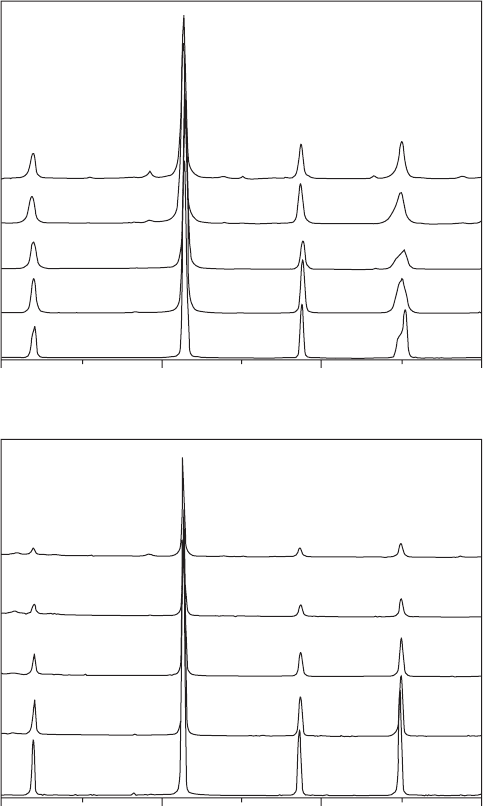
Handbook of dielectric, piezoelectric and ferroelectric materials454
(Algueró et al., 2005a; Jiménez et al., 2006). The material presents a transition
between the monoclinic Cm ferroelectric phase and the non-ergodic relaxor
state with well-defined, different transition (
T
C
h
= 71 °C and
T
C
c
= 61 °C on
heating and cooling, respectively) and freezing (T
f
= 77 °C) temperatures.
Pe
Pe
Pe
Pe
Pe
Py
Pe
Pe
Pe
20 30 40 50
2θ(°)
20 30 40 50
2θ(°)
Intensity (a.u.)Intensity (a.u.)
HP at 700 °C
HP at 800 °C
HP at 900 °C
HP at 1000 °C
1200 °C in PbO
HP at 700 °C
HP at 800 °C
HP at 900 °C
HP at 1000 °C
1200 °C in PbO
0.65 PMN–0.35 PT
0.8 PMN–0.2 PT
15.2
XRD patterns for the PMN–PT ceramic materials processed from
the mechanosynthesised powders (Pe: perovskite, Py: pyrochlore).
Sintering conditions aimed at obtaining decreasing grain sizes are
indicated (HP: hot pressing).
WPNL2204
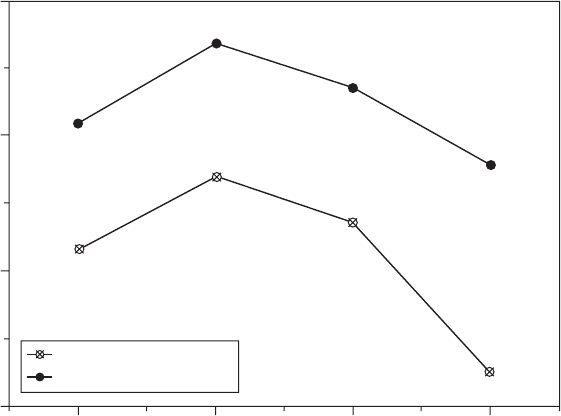
Size effects on the macroscopic properties 455
The transition also presents thermal hysteresis in the kinetics that is much
slower on cooling than on heating. This indicates that quite a sharp slowing
down occurs in the temperature interval between the transition temperatures
on cooling and heating.
These features were established by studying the temperature dependence
of the dielectric permittivity and the Young´s modulus across the transition
in combination with thermal expansion measurements. The dielectric
permittivity measured on heating at five frequencies is shown in Fig. 15.5
for a ceramic with 4 µm grain size. Note the sharp increase between 67 and
77 °C, and the relaxor-type characteristics above the latter temperature. This
corresponds to the freezing temperature T
f
, obtained by the fit of the frequency
dependence of the temperature of the maximum dielectric permittivity, T
m
,
to the Vogel–Fulcher relationship, as shown in Fig. 15.6. The permittivity
presents a clear thermal hysteresis, as illustrated in Fig. 15.7 for the same
ceramics at 10 kHz. A sharp decrease is not observed on cooling at any
temperature. The thermal hysteresis of the Young´s modulus is shown in the
same figure. The minima are associated with the phase transition, which is
much sharper on heating than on cooling, reflecting the slowing down of the
phase transition within the temperature interval between the transition on
heating and cooling: 71 and 61 °C. The slowing down can be interpreted
Weight and volume
Quantitative microscopy
0.8 PMN-0.2PT
96.3%
98.5%
97.3%
95.2%
93%
95%
94%
90%
700 800 900 1000
Hot pressing temperature,
T
(°C)
Density (g/cm
3
)
8.1
7.8
7.5
7.2
15.3
Density measured by two different techniques for the 0.8PMN–
0.2PT ceramic materials processed by hot pressing the
mechanosynthesised powders at decreasing temperatures.
WPNL2204
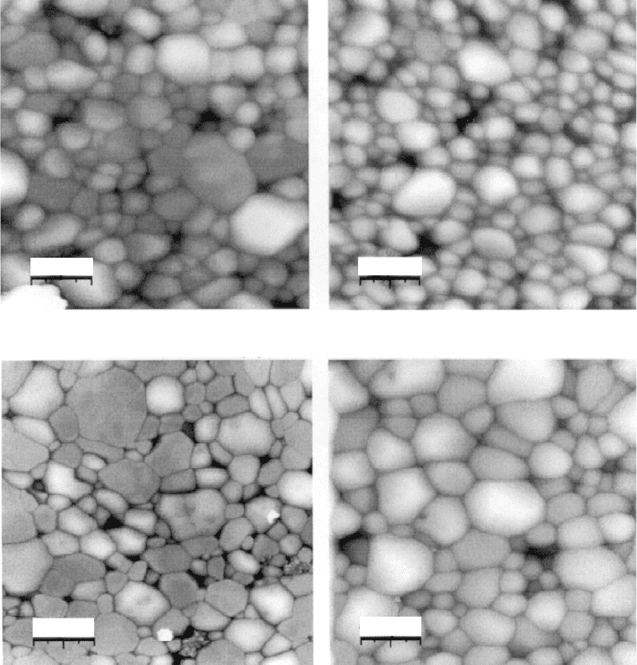
Handbook of dielectric, piezoelectric and ferroelectric materials456
within the two-stage model for the development of ferroelectric long-range
order in relaxor systems, as recently proposed by Ye et al. (2003). In the first
stage, PNRs start condensing at high temperature. Their number and size
increase as the temperature is decreased until the temperature of the phase
transition is reached. Then, the second stage begins that is characterised by
the onset of ferroelectric fluctuations. The model proposes that the kinetics
of the transition is controlled by the number of PNRs at the onset of the
ferroelectric fluctuations, which depends on temperature. Therefore, the slower
the kinetics, the lower the temperature of the transition. The thermal hysteresis
0.8 PMN-0.2PT
200 nm 400 nm
(a) HP at 700 °C (a) HP at 800 °C
800 nm 400 nm
(d) HP at 1000 °C (c) HP at 900 °C
15.4
Atomic force microscopy images of polished and thermally
etched surfaces of the 0.8PMN–0.2PT ceramic materials processed by
hot pressing (HP) the mechanosynthesised powders at decreasing
temperatures.
WPNL2204
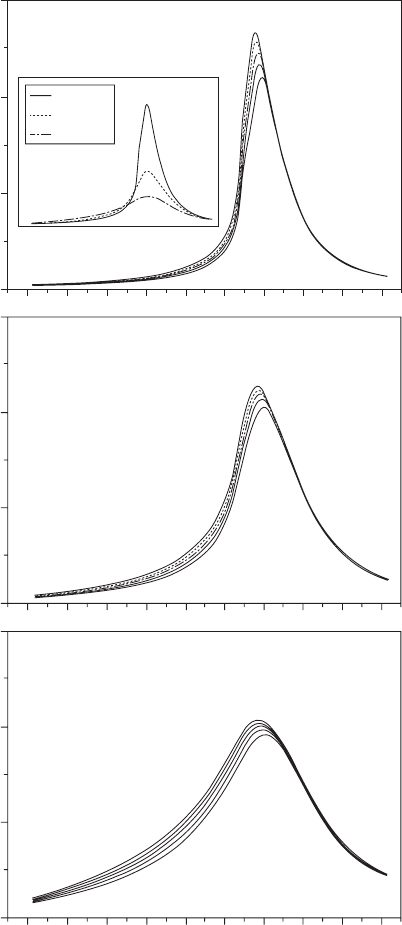
Size effects on the macroscopic properties 457
4 µm
0.4 µm
0.15 µm
0.8 PMN–0.2 PT
4 µm
0.4 µm
0.15 µm
0.1, 1, 10, 100, 1000 kHz
–200 –150 –100 –50 0 50 100 150 200 250
Temperature,
T
(°C)
Real permittivity, ε (xε
0
)
30000
20000
10000
0
Real permittivity, ε (xε
0
)
15000
10000
5000
0
Real permittivity, ε (xε
0
)
9000
6000
3000
0
15.5
Dielectric permittivity measured on heating at five frequencies
for 0.8PMN–0.2PT ceramics with decreasing grain size. Curves at 10
kHz are directly compared in the inset.
WPNL2204
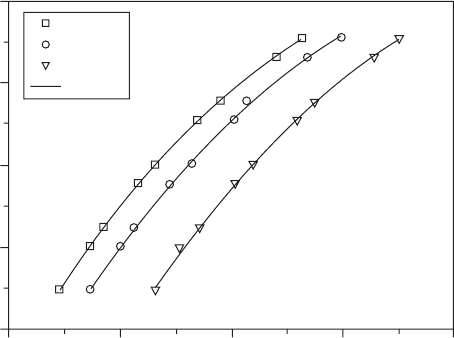
Handbook of dielectric, piezoelectric and ferroelectric materials458
in the kinetics of the transition for 0.8PMN–0.2PT would then be a consequence
of the hysteresis in the temperature of the transition, and of the transition
being slowed down in this interval.
The same macroscopic properties for ceramics with 0.4 and 0.15 µm grain
size are also shown in Figs 15.5–15.7. Note the absence of dielectric dispersion
above T
m
for the submicrometre size ceramics (see Fig. 15.5). This indicates
the absence of Maxwell–Wagner type polarisation at the grain boundaries,
which is associated with the presence of segregated second phases or defects
(Buscaglia et al., 2006). The permittivity still presents a sharp, yet less
pronounced, increase on heating for the ceramic with a grain size of 0.4 µm,
but not for the sample with a size of 0.15µm. A direct comparison of the
permittivity values of all materials with different grain sizes is given in the
inset of Fig. 15.5 at 10 kHz. The broadening and depression of the maximum
with the decrease in size is similar to that observed in BaTiO
3
(Zhao et al.,
2004) and is thus most probably a boundary effect. Note that ceramics present
similar permittivity values at 250 °C in spite of the large difference in the
density of boundaries, which further indicates the good quality of the materials
processed. The high-temperature relaxor state exists for all sizes. Fits to the
Vogel–Fulcher relationship for the submicrometre-structured materials are
also given in Fig. 15.6. The parameters of the fits are given in Table 15.1. No
size effect was observed on either the freezing temperature or the activation
energy. The thermal hysteresis of permittivity and Young’s modulus for the
ceramics with submicrometre grain sizes are also shown in Fig. 15.7. The
4 µm
0.4 µm
0.15 µm
V-F fit
0.8 PMN–0.2 PT
17
14
11
8
4
In (ω)
88 92 96 100 104
T
m
(°C)
15.6
Temperature of the maximum dielectric permittivity,
T
m
, as a
function of frequency, and fit to the Vogel–Fulcher relationship for
the 0.8PMN–0.2PT ceramics with decreasing grain size.
WPNL2204
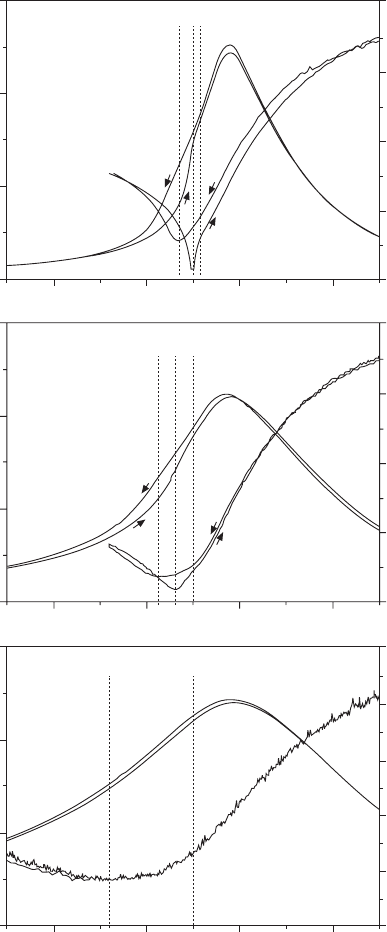
Size effects on the macroscopic properties 459
15.7
Thermal hysteresis of the dielectric permittivity at 10kHz and
Young’s modulus across the transition for the 0.8PMN–0.2PT
ceramics with decreasing grain size.
0.8 PMN–0.2 PT
4 µm
0.4 µm
0.15 µm
Real permittivity, ε (xε
0
)
30000
20000
10000
0
Real permittivity, ε (xε
0
)
15000
10000
5000
0
Real permittivity, ε (xε
0
)
7500
5000
2500
0
0 50 100 150
Temperature,
T
(°C)
TTT
C
c
C
h
f
T
C
T
f
0 50 100 150
0 50 100 150
Young’s modulus,
Y
(GPa)
260
220
180
140
100
Young’s modulus,
Y
(GPa)
230
200
170
140
100
Young’s modulus,
Y
(GPa)
85
80
75
70
65
60
TTT
C
c
C
h
f
WPNL2204
